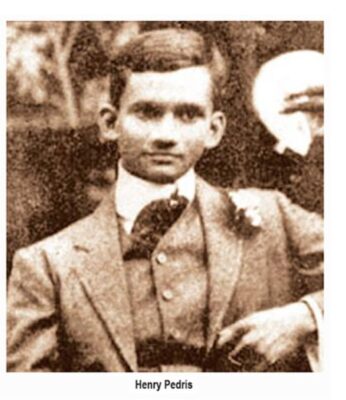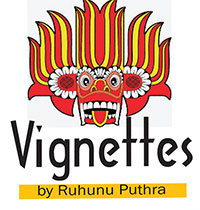Reminiscences of Dangedera village in Galle

Source:Island
About three quarters of a mile to the north of the centre of the Galle Town is the Dangedera village. The road to Baddegama runs across it. And, the Moragoda River abuts it on the east.
There are two schools of thought as to how its name originated. One is that it is named after a house (gedera) that existed there, which gave alms (dan).
The other is that it is in so named after a house with a garden full of dan (Eugenia corymbosa) trees. Dan is a small sweet fruit dark purple in colour with a seed.
The village Dangedera is also referred to in the ancient Rishis ola leaves in India, written thousands of years ago. They give a detailed account of its physical features and the Moragoda River, which abuts it. Even the vocations of those living there are given in them.
 The Dangedera village came into much prominence with the death of the national hero.
The Dangedera village came into much prominence with the death of the national hero.
Diyunge Edward Henry Pedris, who was born in the village on 16 August 1888, at “Pedris Villa”. Pedris was a Captain of the Town Guard at the time of the 1915 riots, who sprang into action and opened fire to quell the mob.
Some Europeans who were very envious of his impressive Captain’s uniform and insignia and his horsemanship were hell bent on harming him.
A few days later he was court-martialled for inciting mob violence and for using firearms with no orders to do so. And as a result, he was condemned to death by shooting on 07 July at 8.00 a.m. He displayed rare courage at his death that any Sri Lankan could be proud of.
Most of the houses in the village had his framed photograph displayed. Dayananda was a friend of mine whose surname was Diyunuge and was very proud of it.
Two houses in the village had informal names. They were “Soldera gedera” and “Sabapathi gedera”. “Soldera gedera” was a house with an upper floor – a rarity at the time. Benett was one of my friends there. “Sabapathi gedera” was the residence of the chairman (Sabapathi) of the village volunteer conciliators who resolved minor disputes in the village. Cyril and Basil were two of my friends there.
The village had a mixed population of Muslims and Sinhalese with the latter in preponderance. They lived harmoniously.
There were two temples, two mosques and a Sinhala school in the village. Only a few families owned cars. There was public transport on the highway. The rickshaw, the buggy and the hackery, supplemented the public transport.
The village had eminent lawyers, other professionals, state and private sector employees, businessmen in Galle and in Colombo, gem merchants and those engaged in gem industry, daily wage earners and casual workers.
Surveyor Thomas Ambawatta, a trade union leader, who hailed from this village, was the first surveyor to engage in fieldwork, donning the national dress.
The headmaster of the Dangedera school was Jagoda iskole mahattaya, who came to the school before time to open the school gate. He was popular and won the hearts of all. Then there was Jayatissa iskole mahattaya, who was a strict disciplinarian. Some of the other much-loved dedicated gurus were Wijesekera, Danny, Semage, Sumathipala Maitipe.
I could also remember that the death anniversary of Henry Amarasuriya (Senior), a benefactor of the school, was a holiday,
Guru John Kulasuriya, who was from this village, was the art master of Mahinda. He composed the college song, Siri Lanka Dakshina Disa Rama Mahinda though he is not credited with it.
Then there was the odd teacher out, who served a jail sentence for murdering his brother.
One of the prominent families in the village was the Wimaladharma family, who had their business establishment in Colombo – “The Wimaladarma Brothers” also known as “The timekeepers to the nation”. One of the brothers was a Galle Municipal Council or another was the all-round sportsman Gunapala Wimaladharma, who captained Mahinda College cricket and football teams—a rare feat. He completed dental studies in the UK, and became Dental Surgeon.
I cannot but gratefully recall that one of his elder brothers, Ariyaratna Aiyya, used to give me pillion rides on his bicycle when I was a child.
The Wijetunga family was another prominent family in this village. U. N. Wijetunga, the watch magnate who hailed from this village, had his primary education the Dangedera Jayawardena school and later joined the Ananda and Nalanda Colleges in Colombo.
A great social worker, his resounding success did not make him forget his native village of Dangedera, a rare trait, when many a villager who achieved VIP status breaks ties with the kith and kin and the village. He was also a keen turfite who named his horses with Sinhala names and called himself Mr. Nel as the owner. He won the Governor’s Cup and several other trophies.
His fearless mother gave leadership to the women folk in the village.
His elder brother, Tudor Wijetunge, was a leading businessman in the Galle Bazaar, specializing in spectacles and watches. He and his wife were great social workers in the village. The poor village women folk affectionately called their much-loved benefactors Semi Nona.
One of their sons Douglas was a British-qualified optometrist who stepped into the social service arena. Once he was the president of the Galle Jaycees Chapter and later the president of the Lions Club of Galle 306A. He was a close friend of mine and so was his cousin Ranjith Wijetunga, who as a lawyer. Right now, the only link I have with the Dangedera village is Noel, a leading businessman in Galle, who is a brother of Douglas.
Sadaris Mudalali, the proprietor of Runsing Group travelled in his red-coloured Morris 8 car; he was dressed in his tweed cloth and white coat. He was highly respected in the village, and he became famous after he gave evidence before the Donoughmore Commission on constitutional reforms. One of his sons, R. H. Dhanapala, was a popular figure in the village.
Francis, Marshal, Peter and Martin mudalalis had their establishments in Colombo.
The Weerapperuma family with two station masters was another prominent family in the village. (Susunaga was a friend of mine).
I could remember Geeris Mudalali going for his constitutional with a walking stick in hand.
As a student at Mahinda, G. R. Edward was a painter, flautist, singer and dancer. Back in Ceylon from Shantiniketan, he melodiously sang. Sadly, his life ended fairly young in a train mishap.
One day, I was summoned to the District Court of Galle to give evidence. As there still more time to commence the court proceedings, I dropped in to the law library and was with my lawyer friends there.
Just then, a lawyer came in and placing his hand on my shoulder said with a broad smile, “My mother says that she had to breastfeed you, after your mother’s death, when you were an infant”. Then we all had a hearty laugh. After he left, my friends told me that he was the Senior State Counsel P. H. K. Kulatilake, then at Galle, at the time.
Then I remembered him to be a son of my one-time illustrious neighbour. I also remembered that he was a clever debater who led the English debating team of Mahinda and also as one who won the much coveted “Pearce Prize” and the “Olcott Prize”; he later gained entrance to the university.
Thereafter, I learnt that he entered the University of London for a postgraduate course. And eventually, he joined the Attorney General’s Department and retired as a Justice of the Appellate Court. I regret to this day that I have had no occasion to meet him, at least to convey that my elders confirmed what he had said that day at the law library. His elder brother Ariya Tissa was a good friend of mine.
When A. M. M. Thahir JPUM and one-time Crown Proctor of Galle, who hailed from Dangedera, celebrated 50 years at the bar with a traditional Muslim lunch, a Sinhala lawyer recited this impromptu verse:
“Thair mathindu hata handa dhei mini gejji,
Siriyawak thibey mehi ulelaka Hadjii,
Karunak kiyami eya kiyumata noma lajji,
Adupaduwak thibuney neti eka Sabji”.
(Today golden bells chime for Mr. Thahir, and the atmosphere here has the festive air of Hadjji. But I must say this boldly, and that is, the only thing missing here is Sabji, a preparation sometimes served at Muslim functions which makes the partaker feel on top of the world.)







